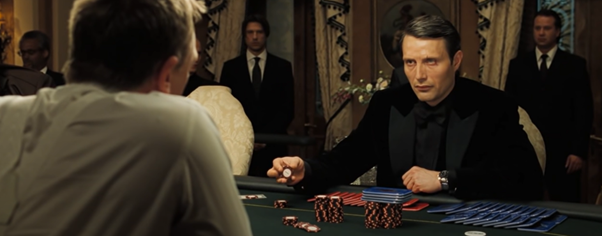James Bond has long been linked with the world of gambling. The casino bonus sequences have become a mark of the film series, and the poker game in Casino Royale stands out among these moments. This scene brings together high stakes, strategic play, and superb acting. It also shows the evolution of the character and the shift in the way gambling is portrayed in the films.
Bond and Gambling in Film
Gambling has played an important role in the Bond films since the early years of the series. The secret agent is not only skilled in combat and espionage but also in card games. Earlier films often showed Bond engaging in baccarat, a game that relies heavily on chance. However, Casino Royale switched the focus to poker, a game that demands skill and strategy.
The change from baccarat to poker in the film reflects a shift in the gambling world. Poker has grown in popularity over the years, partly due to the rise of online gaming and large tournaments. Many viewers find poker more appealing because it requires tactical decisions rather than simply relying on luck. This change brings a modern feel to the film while still respecting the tradition of Bond’s gambling habits.
The Poker Game and Its Impact
In Casino Royale, the poker game is not just a game. It is central to the film’s plot and character development. Bond faces off against the villain Le Chiffre in a high-stakes Texas Hold’em tournament. The stakes are high as the outcome of the game has significant consequences. Le Chiffre needs to win back the money lost in a previous scheme. Failure would force him to take desperate measures that would expose secrets of national security.
Bond is chosen to play in the game because his skills on the card table are as impressive as his skills in combat. The game serves as a battlefield where strategy replaces physical violence. The tension is built through careful direction and subtle acting, creating a scene that captures the audience’s attention throughout its duration.
Key Elements of the Scene
A few factors contribute to the scene’s lasting appeal:
- High Stakes: The enormous pot and the pressure on both players add intensity.
- Strategic Play: Texas Hold’em requires a deep understanding of risk and probability.
- Character Development: The game reveals aspects of both Bond and Le Chiffre.
- Tension: Every move is laden with potential consequences, creating suspense.
- Modern Appeal: The shift to poker reflects the current interest in the game.
The Shift from Baccarat to Poker
The original book by Ian Fleming, published in 1953, featured baccarat as Bond’s game of choice. The film adaptation of Casino Royale, however, decided to change the game to Texas Hold’em. This decision was made for several reasons.
A more popular game would resonate with a larger audience. Poker is well known and played by many, especially with the growth of online gaming. The availability of online poker sites has made the game accessible to a broader public. The strategic depth of poker also adds a new dimension to the scene. While baccarat is largely based on chance, poker demands that players make calculated decisions that can alter the course of the game.
A Table of Comparisons
The table below highlights the differences between baccarat and poker as portrayed in Bond films:
| Feature | Baccarat | Poker (Texas Hold’em) |
| Game of Chance | High reliance on luck | Mix of luck and skill |
| Strategic Depth | Limited strategic options | Requires tactical planning |
| Audience Familiarity | Less common in modern play | Widely played and popular |
| Role in Plot | Often a background detail | Central to plot development |
| Emotional Intensity | Lower | Higher due to player decisions |
This comparison shows why the filmmakers chose poker over baccarat. The change adds a layer of strategy and increases the overall tension of the scene.
The Tension and Acting
The poker scene is remembered not just for its gameplay but also for its execution. Bond, played by Daniel Craig, and Le Chiffre, portrayed by Mads Mikkelsen, engage in a psychological battle. Each player uses the game as a tool to demonstrate their character traits.
The tension in the room is palpable. Every move is critical, and the risk of losing is significant. Bond’s calm demeanour under pressure contrasts sharply with Le Chiffre’s desperate attempts to control the game. Their performances bring depth to the narrative. The actors convey a mix of determination and vulnerability, making the scene memorable.
Despite a few minor errors in the portrayal of poker rules, the film manages to maintain its credibility. One notable error occurs when Bond, after winning a large pot, tips the dealer with a chip. In a tournament setting, this gesture lacks the same meaning it would have in a cash game. However, this small mistake does little to diminish the overall impact of the sequence.
List of Tension-Building Techniques
The film uses several techniques to build tension in the scene:
- Close-Up Shots: These capture the expressions of the players and highlight the stakes.
- Steady Camera Work: A steady camera enhances the feeling of focus and control.
- Quiet Background Music: The score adds to the suspense without distracting from the action.
- Pacing: The careful pacing ensures that every moment feels significant.
- Subtle Lighting: The lighting choices underline the dramatic nature of the scene.
These techniques contribute to the lasting appeal of the poker sequence. They work together to keep the audience on edge as the game progresses.
The Role of High Stakes in Casino Royale
The stakes in Casino Royale are not measured in small sums. The enormous pot in the poker game reflects the high risks involved. Le Chiffre’s financial troubles and the need to recoup losses add a layer of urgency. The film uses the game as a way to set the stage for larger conflicts in the narrative.
The pressure on the players is intense. For Le Chiffre, the game represents a chance to avoid personal and professional ruin. For Bond, it is an opportunity to thwart a dangerous enemy. The high stakes of the game drive the narrative forward, making every decision count. The game becomes a metaphor for the larger battle between order and chaos, where one wrong move could have dire consequences.







